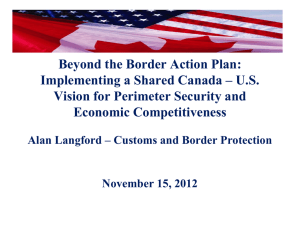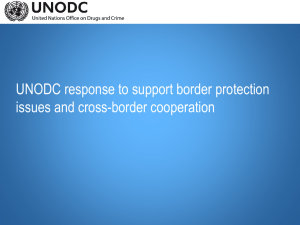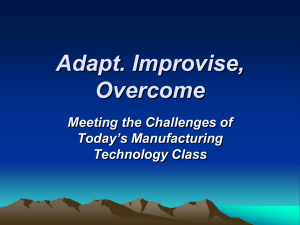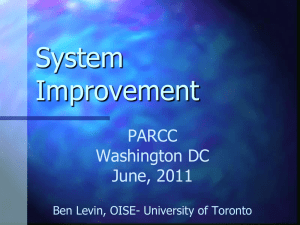Border and Ontario Economy
advertisement
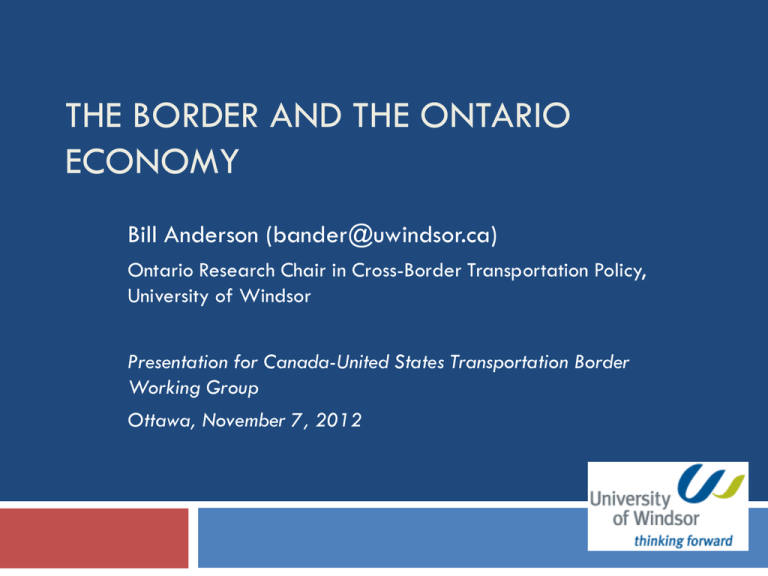
THE BORDER AND THE ONTARIO ECONOMY Bill Anderson (bander@uwindsor.ca) Ontario Research Chair in Cross-Border Transportation Policy, University of Windsor Presentation for Canada-United States Transportation Border Working Group Ottawa, November 7, 2012 Ontario’s cross-border economy 5 points about the Ontario Economy 1. Ontario has an trade-oriented economy (Imports and exports as % of GDP, 2010 data) 45% 40% 35% 30% 25% 20% 15% 10% 5% 0% imports exports 2. Exports are focused on the US market (2010 data) China, 1% Norway, 1.3% Mexico, 1.4% United Kingdom, 6.9% Rest of World, 9.5% United States, 79.9% 2a Ontario exports 2010 ($million) $180,000 $160,000 $140,000 $120,000 $100,000 $80,000 $60,000 $40,000 $20,000 $0 Interprovincial US Other International 2c Highway distance (km) from Toronto 2500 2000 1500 1000 500 0 3. Most Ontario merchandise exports are of manufactured goods (2010 data) All other 12.7% Automotive Mfg, 35.6% Other Mfg, 51.7% Source: Industry Canada International Trade Database, adapted from Statistics Canada 4. Most exports to the US move by truck Rail 17% Other 10% Truck 73% Ontario's Exports to the US by mode, 2007-2008 Source: Transport Canada (2008): Transportation in Canada 2008 5. Truck movements are concentrated at a few crossings Ontario’s prosperity is highly dependent on the performance of a few border crossings Cross-Border Supply Chains More than just exchange of finished goods, an intermingling of production systems Windsor, Ontario’s largest automotive plants Vans assembled from US parts Engines for US-assembled trucks and cars Just-in-Time: little tolerance for delays, disruptions and high transfer costs Border costs make firms engaging in cross-border supply chains less efficient and competitive The Cost of the Border Border crossing costs for goods • • • • • • • Duties, fees, tolls Document prep, broker fees (rules of origin) Empty backhauls Average Delay Delay Uncertainty Compliance with trusted trader programs Cross-border business trips Ambassador Bridge to US Planning Time (minutes) 90 80 70 60 Mean 50 PT90 40 PT95 30 PT99 20 10 0 2006 2007 2008 2009 Strategies to mitigate crossing time uncertainty in supply chains • • Excess Plan Time – Costly because it ties up trucks, reduces the number of turns per day Inventory stockpile – A “just in case” strategy, but it increases inventory carrying costs Border cost estimates Taylor et al (2004) study found that border costs are equivalent to 2.7% ad valorem tariff (4% for trucks) Carrier costs only about 25% of total Customs administration is a major component Recent study from Fraser Institute makes total cost of pot 9/11 border impacts (lost trade and tourism, government expenditures) at 1.2% of Canadian GDP Trucking costs as percentage of goods value (Mark Brown, Statistics Canada) Percent 4.0 3.5 3.0 2.5 2.0 1.5 1.0 0.5 0.0 2004 2005 Domestic 2006 2007 Export 2008 Import 2009 Why are cross-border shipments more expensive? Cross-border trucking costs 8% to 40% higher than comparable domestic (.4 -.9% of value) Border delays and uncertainty Cost of compliance with trusted trader programs Common queue problem Empty backhaul Lack of cabotage rights under NAFTA Trends in cross-border movement of goods and people Canada-US trade stagnating in 21st century Ontario Trade values still below 2001 level At national level, Ontario’s decline offset by oil exports Rapid reduction in personal crossings by automobile Canadian Exports to the US: total and Ontario 400 350 300 250 200 150 100 50 - Total Ontario Canadian exports to the US: Total and Oil and Gas 400 350 300 250 200 150 100 50 - Oil and Gas All others Factors that retard trade High and volatile Canadian dollar Slowdown in automotive and other key manufacturing industries Increased competition from China and others Costs of the border Automobiles entering Canada at Ontario Crossings 1972-2010 16,000,000 14,000,000 12,000,000 10,000,000 Total United States vehicles entering Canada at Ontario crossings 8,000,000 Total Canadian vehicles returning to Canada at Ontario Crossings 6,000,000 4,000,000 2,000,000 1972 1975 1978 1981 1984 1987 1990 1993 1996 1999 2002 2005 2008 0 Policy Policy Options Make the border more efficient Infrastructure, personnel Technology (RFID, biometrics, databases) Move functions away from the border Trusted trader (FAST), traveler (NEXUS) IBETs, intelligence The perimeter approach Eliminate border functions through harmonization Problems: no customs union, major policy differences (immigration/refugee, firearms, tax structure) Perimeter Security and Economic Competitiveness Action Plan Practical steps, short timelines, little legislative requirement Responds well to business interests Greater coordination and cooperation Information sharing (entry-exit) CBP and CBSA operation on foreign soil Joint plans on infrastructure, resilience Not much for the occasional traveler Directions for Policy Development Aggressive incrementalism Infrastructure where needed Perform border functions jointly Customs administration and data requirements, Plan for border resilience World’s most technologically advanced border Privacy and human rights issues Don’t neglect the occasional border crosser Don’t get complacent because of oil and gas
